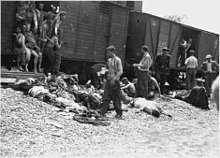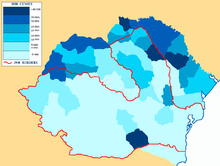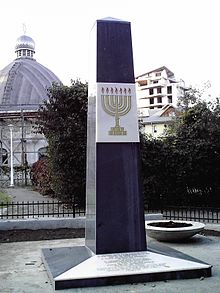Death train from Iași
The death train from Iași , also known as the Iași pogrom , marked the end of the largest pogrom against the Jewish population in Romania . It took place in the city of Iași a week after the start of the German-Soviet War on June 29, 1941 . The pogrom was carried out by Romanian government troops - partly supported by German units - under the supervision of the Romanian authorities. Over 13,000 people died in the course of the pogrom.
background
In October 1940 General Ion Antonescu took over the affairs of state and government in Romania. At the same time, Iași was named the capital of the Iron Guard , comparable to Munich as the capital of the movement for the National Socialists. The city's appointment as the center of the anti-Semitic Iron Guard was associated with intensified repression against the local Jewish population. This included not only attacks, but also the confiscation of Jewish property and real estate. The riots were associated with open anti-Bolshevism . Just a month later they culminated in the destruction of two synagogues . In 1941 51,000 Jews lived in the city.
The pogrom was similar to the Dorohoi pogrom a year earlier on July 1, 1940. According to the historian Jean Ancel (1940-2008), who survived the massacre in a basement hiding place and then lost over 20 family members, Antonescu ordered the bloody act in a telephone conversation with General Constantin Lupu personally on June 27th. Accordingly, the Iasi pogrom was related to Antonescu's overall plan to physically exterminate all Jews in Bessarabia , Bukovina and Moldova . Although the essential facts about the course of the massacre are known, there are different views among historians about the specific trigger. According to Vladimir Solonari, an order from Antonescu cannot be explained by its subsequent reaction. After the massacre, Antonescu first gave the version of the military, according to which the Jews had shot the soldiers first, which had to be sanctioned. On July 4th, Antonescu publicly regretted the pogrom. Antonescu said the events of the "individual, acting on their own initiative" soldiers would cast the military in a bad light, which is why he ordered an investigation.
Course of the pogrom
The Romanian secret service spread rumors in the city that the Jewish population had given the Soviet Union Air Force information about the bombing of the city. Incited by the armed units of the Romanians and Germans, the first attacks began on the eve of June 28th. While thousands have been arrested, similar numbers have been murdered on the street or in their homes. There was also looting. Fearing the angry mob, residents marked their property with: "Christians live here, not Jews."
On June 29th, known as "Black Sunday", shootings by Romanian soldiers began in the back yard of the police headquarters. The 4,330 survivors - according to other sources 7700 - were then driven into closed freight cars . The first of two trains consisted of between 33 and 39 freight cars into which 2,430 to 2,530 people were driven with rifles and bayonets. He left Iasi at around 4 a.m. on June 30th. The two trains drove the locked wagons through the Romanian hinterland for eight days. Most of the prisoners died of hunger or thirst. The air vents were boarded up so that the trapped could hardly breathe. On July 6, the first train that had driven via Târgu Frumos , Roman , Mărăşeşti and Ploieşti reached the Călăraşi station . The Israeli memorial Yad Vashem recorded 2,650 deaths during this trip.
According to a report by the Romanian secret service from July 1943, 13,266 people were killed in Iași and in the two deportation trains. The Jewish community of Iași names over 15,000 victims.
War crimes trials
The Romanian judiciary charged 57 people with the pogrom in Iași after the war. In addition to 21 civilians and 22 gendarmes , former senior military officers as well as the mayor of Iași and the prefect of the region had to answer. 156 witnesses were summoned by the court. Most of them were survivors of the pogrom.
A large number of the accused were sentenced to long prison terms combined with camp labor for war crimes and crimes against peace , including former generals. The detention was supposed to compensate for the damages. Few of the accused were acquitted.
Commemoration
On June 28, 2011, a black marble obelisk and several memorial plaques on the anniversary of the pogrom were unveiled in front of the Great Synagogue in Iași . It replaced an old obelisk from 1976. The Great Synagogue is the only one of 110 synagogues in the city that survived the war.
The German-Italian writer Curzio Malaparte stayed in Iași as a war correspondent in June 1941 and described his experiences in the documentary novel “Kaputt” (first edition Naples 1944).
See also
literature
- Jean Ancel: The Iasi pogrom on June 29, 1941 . In Wolfgang Benz , Brigitte Mihok (Ed.): Holocaust on the periphery. Jewish policy and murder of Jews in Romania and Transnistria 1940–1944. Berlin 2009, ISBN 978-3-940938-34-3 .
- Jean Ancel: The History of the Holocaust in Romania. (= The Comprehensive History of the Holocaust ). University of Nebraska Press, Lincoln / Yad Vashem, Jerusalem 2011, ISBN 978-0-8032-2064-5 , Chapter 33: The Iași Pogrom, 29 June 1941. pp. 445–469.
- Radu Ioanid: The Iași Pogrom, June-July 1941. A photo documentation from the Holocaust in Romania , Göttingen: Wallstein 2019, ISBN 9783835334496 .
- Jacques zwieback: The death train from Iasi 1941: a survivor of the biggest pogrom in Romania remembers . From the Romanian by Kathrin Lauer. Edited by Erhard Roy Wiehn . Hartung-Gorre-Verlag, Konstanz 2002, ISBN 3-89649-804-5 .
Literary processing:
- Curzio Malaparte : Broken . Novel. translated by Hellmut Ludwig. Paul Zsolnay Verlag, Vienna 2005, ISBN 3-552-05334-4 .
- Cătălin Mihuleac : Oxenberg & Bernstein . Novel. from Romanian by Ernest Wichner . Paul Zsolnay Verlag, Vienna 2018, ISBN 978-3-552-05883-5 .
Web links
- Leila Knüppel: The extermination of the Jews in Romania - memory of the pogrom in Iasi. In: Deutschlandfunk broadcast “Europe today”. July 1, 2019 (also as mp3 audio , 6.2 MB, 6:44 minutes).
Individual evidence
- ^ Jean Ancel: The pogrom of Iași on June 29, 1941. In: Wolfgang Benz, Brigitte Mihok (ed.): Holocaust an der Peripherie. Jewish policy and murder of Jews in Romania and Transnistria 1940–1944. Berlin 2009, ISBN 978-3-940938-34-3 .
- ↑ Bert Hoppe , Hiltrud Glass (arr.): The persecution and murder of European Jews by National Socialist Germany 1933–1945 . Volume 7, Munich 2011, ISBN 978-3-486-58911-5 , p. 64.
- ^ The Massacres at the Beginning of the War. In: The Romanien Jewish Community. Archived from the original on November 14, 2013 ; accessed on January 1, 2019 .
- ↑ a b c d This Month in Holocaust History - Related Resources: Iasi (German, Jassy). In: Yad Vashem. Archived from the original on April 14, 2016 ; accessed on July 1, 2019 .
- ^ Leila Knüppel: Extermination of Jews in Romania. Remembrance of the Iasi pogrom , Deutschlandfunk , July 1, 2019.
- ^ Jean Ancel: The History of the Holocaust in Romania. 2011, p. 445.
- ↑ Vladimir Solonari: Purifying the Nation. Population Exchange and Ethnic Cleansing in Nazi-Allied Romania. The Johns Hopkins University Press, Baltimore 2010, pp. 166f.
- ↑ Bert Hoppe, Hiltrud Glass (arr.): The persecution and murder of European Jews by National Socialist Germany 1933–1945. Volume 7: Soviet Union with annexed areas I - Occupied Soviet areas under German military administration, the Baltic States and Transnistria. Munich 2011, ISBN 978-3-486-58911-5 , p. 64.
- ^ Radu Ioanid: The Antonescu Era. In: Randolph L. Braham (Ed.): The Tragedy of Romanian Jewry . The Rosenthal Institute for Holocaust Studies, Columbia University Press, New York 1994, pp. 131–144, here p. 138.
- ↑ Bert Hoppe, Hiltrud Glass (edit.): The persecution and murder of European Jews ... Munich 2011, ISBN 978-3-486-58911-5 , Volume 7, p. 64.
- ^ Uwe Seemann: Jassy: Remembrance of the victims of the pogrom of June 1941. In: Gedenkstättenportal zu places of remembrance in Europe . 2006, accessed July 1, 2019 .




